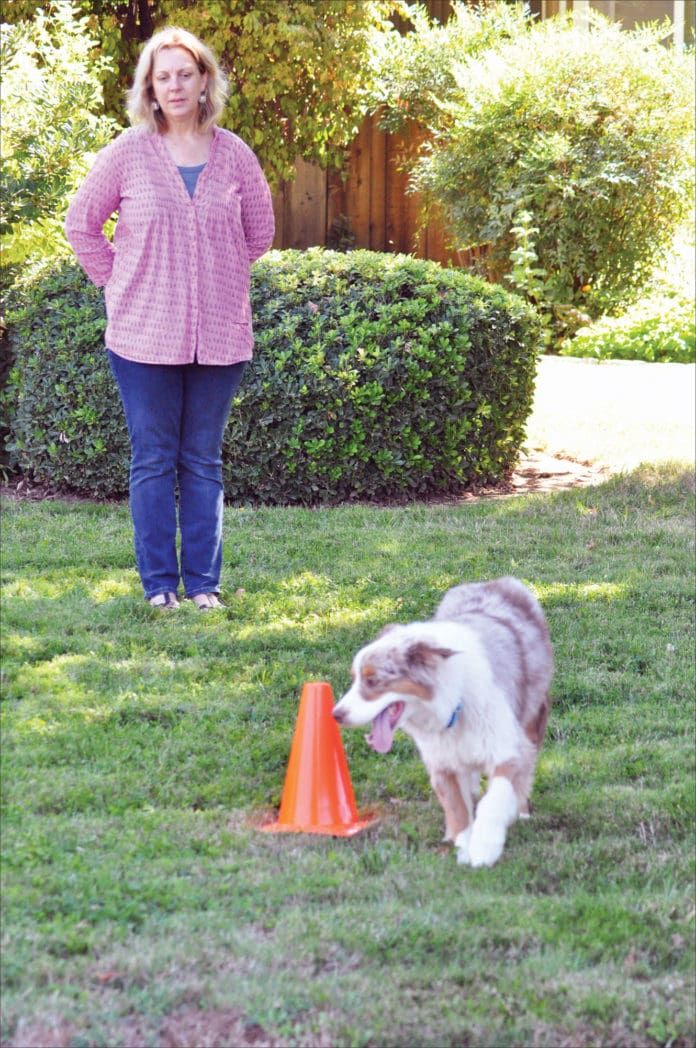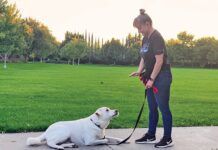I remember, years ago, confidently and assertively telling my training academy students “Dogs don’t learn through imitation.” But, degree by degree, I’ve been proven to be wrong. I’m taking it well, however, because the studies that have established this ability in dogs are so exciting, and their implications have expanded our ability to train and communicate with our dogs so much.
First, there was the 1997 study in which some litters of puppies were allowed to watch their narcotics detection dog mothers while working in a real-life work environment, while other litters of puppies did not. When the pups were six months old, the pups who watched their mothers at work learned the task more easily and quickly than the pups who did not watch.
Later, Ken Ramirez, currently the executive vice president of animal collections and training at Chicago’s world-famous Shedd Aquarium, demonstrated how he taught his dog that the cue “Copy!” means “Do what that other dog just did.” When he shared his “Copy!” procedure at Karen Pryor’s Clicker Expo in 2011, the dog training world sat up and took notice.
Now there is an exciting new development in the study of canine cognition, thanks to Italian PhD ethologist Claudia Fugazza, who is currently studying at Eotvos Lorand University in Budapest, conducting research on social learning and imitation with Professor Adam Miklosi. Fugazza has developed a training method she calls “Do As I Do,” which relies on a dog’s social cognitive skills to learn new behaviors by imitating humans. Did you get that? Fugazza tells us that dogs can learn new behaviors by imitating human behavior.
According to Fugazza, using her training protocol, owners can teach new behaviors to their dogs by simply showing them what to do. Then they can put the new behavior on cue.
This flies in the face of everything I have learned in the past. It makes sound biological/survival sense that dogs could and should be able to imitate each other’s behavior. But imitate the behavior of an entirely different species? Seriously?
Skeptic that I am, I ordered the DVD and was completely and totally gobsmacked. I was so taken by the procedure I immediately determined to try it with one of my dogs, Bonnie, an eight-year-old Scorgidoodle.
A Little Prep Work
It was a humbling experience. For starters, your dog has to know at least three behaviors (other than “Sit!”) on verbal cue – without any body prompting, gestures, or even a sideways shift of the eyes. This is necessary in order to avoid inadvertently giving him a very subtle cue to perform (see “The Clever Hans Phenomenon“).

For Bonnie, I selected the behaviors “Down,” “Tap,” (touch an Easy Button with a paw), and “Up” (step up and sit on a “Stepper”). I discovered that “Down” was solidly on verbal cue, but we needed some work on “Tap” and “Up” to fade the very natural, subtle but unacceptable body prompts. After several brush-up sessions focusing on those two verbal cues, we were ready to proceed.
How Dogs Learn to Imitate
Bonnie needed to learn the “imitation rule” (Phase 1). That is, whatever behavior I do, followed by the cue “Copy!” means “You are supposed to do the same behavior.” (I chose to use “Copy!” rather than Fugazza’s suggested cue of “Do it!” because I use “Do it” to initiate the “101 Things to Do With a Prop” game.)
I stood in front of Bonnie, told her to “Wait,” and then did the behavior myself (either push the button, step up and sit on the Stepper, or lie down facing her). Then I returned and gave the “Copy!” cue, followed by the verbal cue for the behavior I had just performed, without any body-language prompting. In theory, the association between repetitions of “Copy!” and the verbal cue for the behavior that was just demonstrated, teaches the dog that “Copy!” means “Do whatever I just did.” Would it work for Bonnie?
Well . . . eventually. Because the behaviors that I had selected for her weren’t as solidly on verbal cue as I had hoped (other than the “Down”), we worked through several permutations of “Copy!”, “Cue!”, and waiting to see what she did. She tended to offer the three behaviors somewhat randomly at first; alternatively, she’d sit and wait, looking at me hopefully for further instructions. Each time I got an incorrect response (or no response) I started over: cued her to “Wait” while I performed the behavior, returned to stand in front of her and said “Copy!”, followed by the appropriate verbal cue. It wasn’t until our third practice session that I began to see glimmers of understanding; hesitantly at first, then with growing confidence, Bonnie would perform the correct cued behavior.

When I could see that she knew what to do before I gave her the cue for the behavior, I stopped using the cue, using only the “Copy” cue after performing the behavior myself. At first, she seemed confused, and went back to offering random behaviors. If she offered the correct one she got a click-and-treat and very happy praise. If she offered an incorrect behavior I simply reset her, performed the behavior again, returned to stand in front of her, and gave the “Copy!” cue. It was exciting to watch as her correct responses gradually began to outnumber the incorrect ones. I could see she was beginning to understand the “rule.”
I had watched several dogs try to learn the rule on the Do As I Do DVD. Some were brilliant, apparently grasping the imitation rule after just a couple of sessions. Others were still struggling at the end of the two-day seminar. Of course, I assumed Bonnie would exhibit the “brilliant” end of the rule-learning continuum, but in all honesty she was more just slightly toward the brilliant side of center. Or maybe I was the one who was less than brilliant; it was easy to see on the DVD that the dogs with the more skillful trainers learned the rule more quickly. Hmm…
In my defense, the trainers on the DVD had Fugazza herself coaching them. In contrast, I was stumbling around on my own, trying to remember what I had watched, and occasionally hearing bits of Fugazza’s charming Italian accent in my mind’s ear saying, “Mmmm… You ges-turd weeth yur eyez!” when I caught myself glancing at the “easy” button along with my “Copy!” cue.

Nevertheless, despite my ineptitude, Bonnie did seem to catch on to the imitation rule after three days, with several sessions per day. Although we weren’t flawless, we were about 90 percent by the end of the third day; nine out of ten times when I would perform the behavior myself, return to stand in front of her, and then give her the “Copy!” cue, she would perform the behavior.
We’re ready to start Phase 2 (generalization of the rule), adding three more behaviors that Bonnie already knows. These do not have to strictly on verbal cue – apparently that’s most important for the first three behaviors. After the next three are solid, we’ll move on to the very exciting Phase 3, where we will see if Bonnie can copy behaviors that she hasn’t previously been taught. Then we will copy behavior sequences. Woo hoo!
Fugazza believes that her “Do As I Do” method has great potential for application in training, with possibilities for quickly teaching dogs new behaviors, including shaping. Whether or not that proves to be true, it’s great fun to have a new training challenge for me and my dogs. I’m already planning to offer “Copy That” workshops in 2014. Can your dog copy that?






